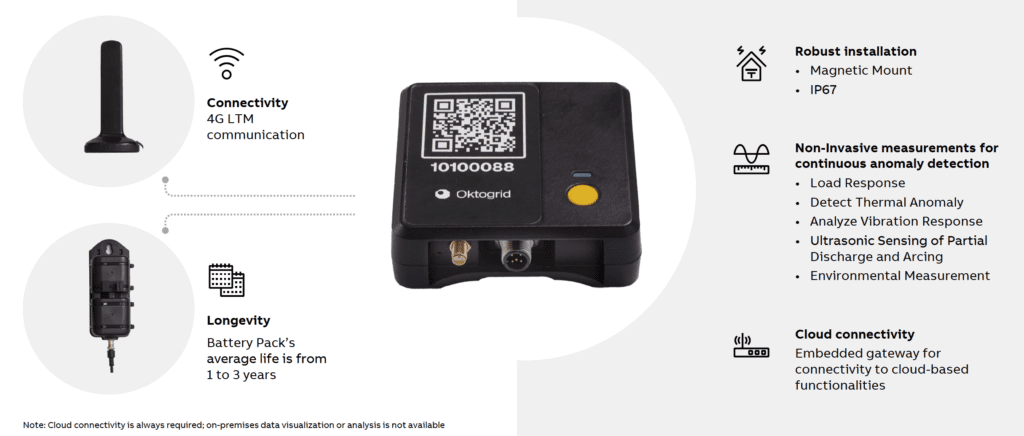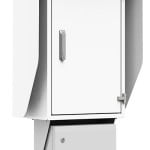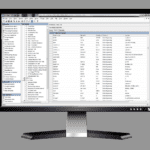ABB Electrification Service recently launched a digital monitoring solution for power and distribution transformers that it says will enhance performance, reliability, and availability of equipment. The transformer sensor is reportedly quick and easy to fit, requiring no screws or tooling for installation. Instead, the sensor, called TRAFCOM, can be mounted magnetically to the transformer within 15 minutes, transmitting data to the cloud almost immediately, significantly reducing the need for any maintenance downtime.
The sensor works independently of transformer type, make, and age, enabling users to benefit from real-time monitoring capabilities all within a single, unified interface as part of an end-to-end asset management system. TRAFCOM measures temperature and humidity, surface temperature, magnetic field, vibration, acoustics, and partial electrical discharges. The cloud-based monitoring solution (Figure 1) allows users to understand a transformer’s condition in real time, enabling operators to detect anomalies early and anticipate failures. This allows planning for maintenance intervals to avoid catastrophe.

POWER interviewed Mahmoud Abdelkhalek, global product manager with ABB Electrification Service, to learn more about the TRAFCOM solution. Abdelkhalek is based in Dubai, United Arab Emirates. Abdelkhalek has worked in the electrical service industry for about 10 years, having been with Schneider Electric prior to joining ABB.
POWER: The digital monitoring solution was reportedly brought to market in collaboration with a Danish start-up called Oktogrid. How did the two companies work together and what was each responsible for?
Abdelkhalek: Our decision to partner with Oktogrid stands testament to our relentless focus on evolving our business and scope of support in line with customer needs. While ABB Electrification Service already had medium- and low-voltage solutions as part of our product lines, we made the decision to partner and invest in Oktogrid in order to be able to provide support for the entirety of one’s electrical infrastructure. We’ve been working with Oktogrid since 2022 and made the decision to formally invest in the startup in January 2023.
TRAFCOM is one of the products that was borne out of this partnership, which was commercially released to the market in January 2024 and was unveiled to the public at Enlit Europe in October 2024. While the hardware for TRAFCOM was developed by Oktogrid, we jointly provide and power the analytics and cloud platform. ABB itself is also wholly responsible for the after-sales services and ongoing support.
POWER: How will the enhanced monitoring capability help companies save money and downtime?
Abdelkhalek: As a remote, real-time monitoring solution, the data gathered by TRAFCOM is analyzed by an algorithm and machine learning technologies. Through pattern recognition, customers are able to anticipate potential equipment failures and better estimate the lifespan of the transformer. This is based on historical technical data collected over time including loading capacity, temperature, vibration, and noise distortion. In the long term, this enables them to implement data-driven predictive maintenance strategies, which save costs and reduces risk of unnecessary downtime.
POWER: What are the most advantageous types of transformers for this solution to be used on?
Abdelkhalek: TRAFCOM was specifically designed to ensure all of our customers could benefit from enhanced monitoring capabilities across the entirety of their electrical infrastructure. With accessibility and ease of installation as core value propositions, we designed the product such that it’s vendor-agnostic, size-agnostic, and type-agnostic. It’s suitable for a transformer of any size or type, whether dry or oil-based.
POWER: How does the cloud feature work? Are companies required to have their own cloud access at sites or is that something ABB provides as part of its service?
Abdelkhalek: The entire ABB Ability Asset Manager for Transformers solution package, within which TRAFCOM is a hardware component, includes a power supply, sensor, and antenna with 4G LTE connectivity, along with a minimum of three years of cloud subscription. This ensures seamless operations irrespective of where the customer is in the world, so as long as 4G coverage is available.
By 2025, we’ll also be offering an on-premise solution, which will allow customers to connect to our cloud system by using their own private internet connections. This will add an additional layer of assurance in reliable connectivity, especially for customers installing TRAFCOM on transformers located in remote areas.
POWER: How does the ABB Ability Asset Manager interface present the data to users and what kind of analytics or predictive capabilities does it offer?
Abdelkhalek: The ABB Ability Asset Manager provides a comprehensive interface that ensures that the customer has a holistic view of their transformers’ performance. This includes a map that clearly depicts the location of each transformer being monitored, a summary of key performance indicators (KPIs) with traffic light indicators, a matrix of transformers onsite including key technical data and main KPIs, temperature trends that indicate the impact of aging transformers, analysis of partial discharge and vibration patterns, as well as alarms for any anticipated failure.
POWER: What kind of return on investment can customers typically expect when implementing this monitoring system?
Abdelkhalek: The return on investment is influenced by multiple factors, most specifically, in terms of mitigating downtime frequency and the cost of production loss during shutdowns. When equipped with tools that allow customers to take a more predictive approach to maintenance, our research has shown that this contributes to a 30% reduction in operational expenses and up to an 80% reduction in maintenance costs. Most importantly, there is an incredible value safety benefit for personnel. As a remote monitoring system, customers no longer need to assign technicians to monitor the transformers at a close distance, reducing the risk of any potential safety breaches.
—Aaron Larson is POWER’s executive editor (@POWERmagazine).











